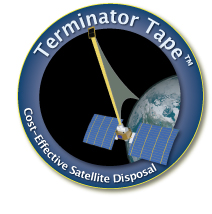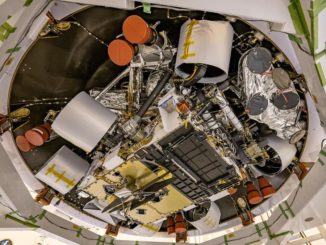
United Launch Alliance engineers filled a Delta 4-Heavy rocket with super-cold liquid hydrogen and liquid oxygen propellants Friday at Cape Canaveral Air Force Station during a practice countdown before the heavy-lifter’s scheduled liftoff in June with a top secret U.S. government spy satellite.
The countdown rehearsal Friday is known as a wet dress rehearsal. The mock countdown provided an opportunity for ULA’s launch team to practice launch day procedures and verify the Delta 4-Heavy’s readiness for flight, reducing chances of a problem cropping up during the real countdown.
About 465,000 gallons (nearly 1.8 million liters) of cryogenic propellants were loaded into the launcher during Friday’s mock countdown, starting with 330,000 gallons of liquid hydrogen for the Delta 4-Heavy’s three Common Booster Cores.
Another 120,000 gallons of liquid oxygen also flowed into the Common Booster Cores. An Aerojet Rocketdyne RS-68A main engine at the base of each booster will consume the hydrogen/oxygen propellant mixture in flight.
The Delta 4’s second stage, powered by an Aerojet Rocketdyne RL10 engine, was also loaded with a smaller amount of cryogenic propellant Friday.
The liquid hydrogen is stored at minus 423 degrees Fahrenheit, while the liquid oxygen is chilled to minus 298 degrees Fahrenheit.
Working from the Delta Operations Center near the Delta 4 launch pad, ULA’s launch team ran through pre-launch procedures before cutting off the countdown before the time the boosters’ RS-68A engines would ignite on launch day. The Delta 4-Heavy was then drained of propellant.
The wet dress rehearsal Friday came around two months after ULA ground teams erected the Delta 4-Heavy rocket — the most powerful vehicle in ULA’s inventory — on the launch mount at pad 37 in November.
The Delta 4-Heavy is set to launch a classified payload for the National Reconnaissance Office, the agency which develops and owns the U.S. government’s intelligence-gathering spy satellites. The identify of the payload is top secret, and the mission is officially codenamed NROL-44.
The payload aboard the NROL-44 mission is likely heading for a high-altitude perch in geosynchronous orbit more than 22,000 miles (nearly 36,000 kilometers) above Earth, where the NRO operates surveillance satellites capable of eavesdropping on foreign communication signals.
If the NROL-44 payload is similar to previous NRO spy satellites launched into similar geosynchronous orbits, the Delta 4-Heavy rocket will deliver its spacecraft passenger directly to a circular orbit some 22,300 miles in altitude, a lofty orbit that typically requires three firings by the Delta 4’s upper stage RL10 engine.
Liftoff of the NROL-44 mission from pad 37 is scheduled for June. It will mark the 12th flight a Delta 4-Heavy rocket since 2004.
ULA has five more Delta 4-Heavy missions its manifest through 2023, all carrying payloads for the NRO that military officials say are unable to launch into their targeted orbits on any other rocket that is currently operational. Many of the NRO’s satellites are heavy and large — comparable to the size of a school bus — and are designed to be integrated with their rockets in a vertical configuration, rather than horizontally.
The final launch of a Delta 4 rocket in its “medium” configuration with a single first stage booster occurred in August 2019.
With the completion of the wet dress rehearsal Friday, ULA says the launch team will complete post-test securing on the Delta 4-Heavy rocket then “pause” activities at pad 37 until closer to the launch date later this year.
One of the final major tasks before liftoff will be the raising of the NROL-44 payload and its payload fairing atop the Delta 4-Heavy a few weeks before liftoff.
Ground crews from ULA will be busy with other missions during the coming months, including a series of up to four Atlas 5 launches planned through mid-2020 from Cape Canaveral.
Preparations to stack another Delta 4-Heavy rocket on its launch pad at Vandenberg Air Force Base are also expected to commence in the first half of this year, ahead of its planned liftoff with another NRO spy satellite payload in late 2020.
Email the author.
Follow Stephen Clark on Twitter: @StephenClark1.



